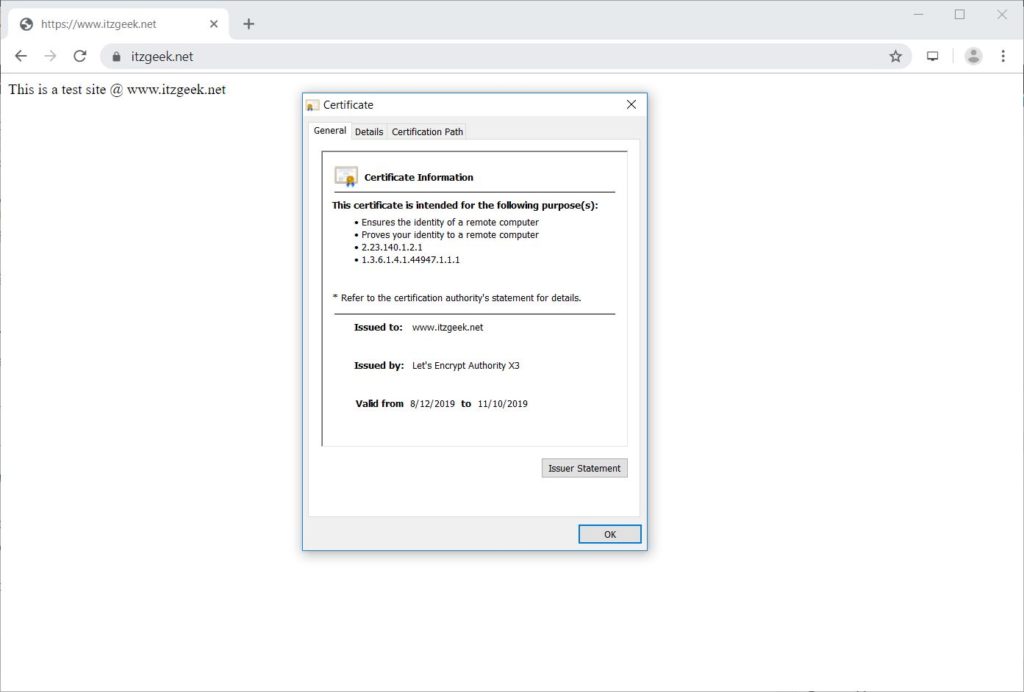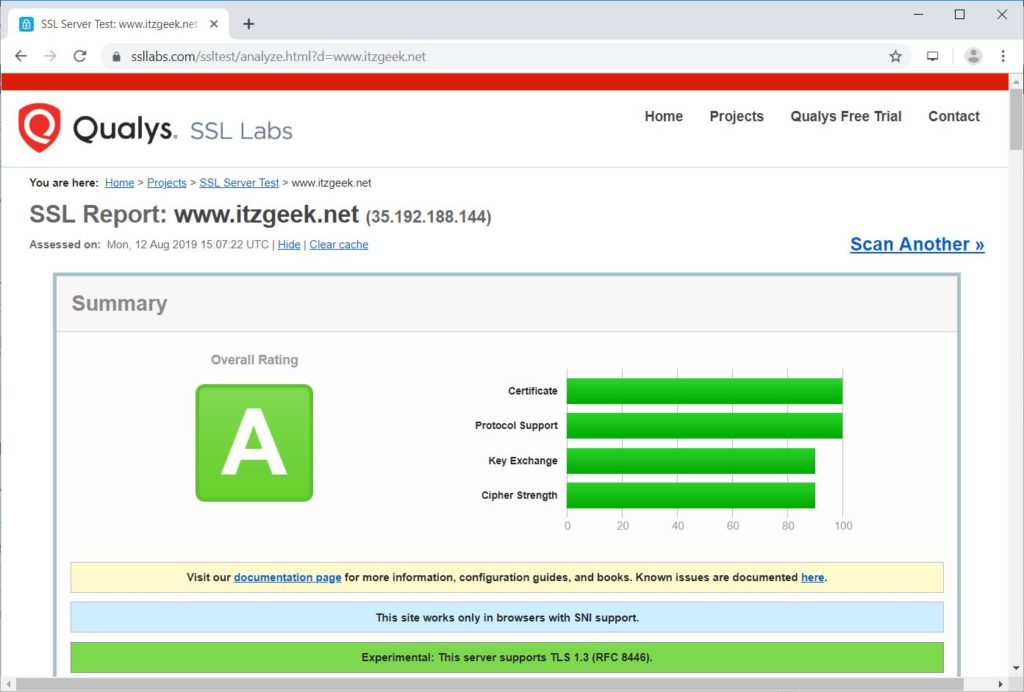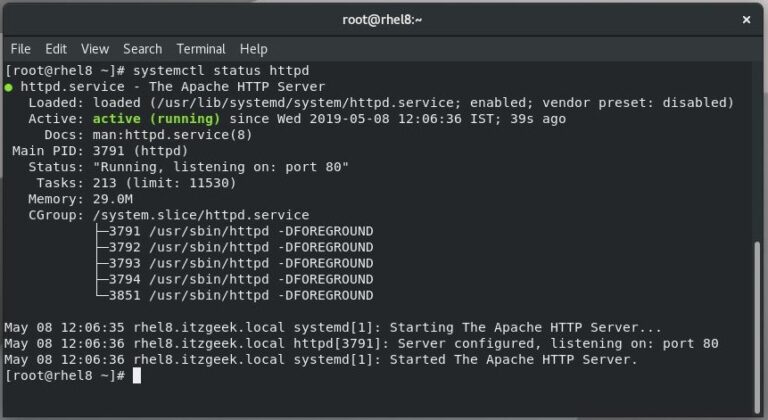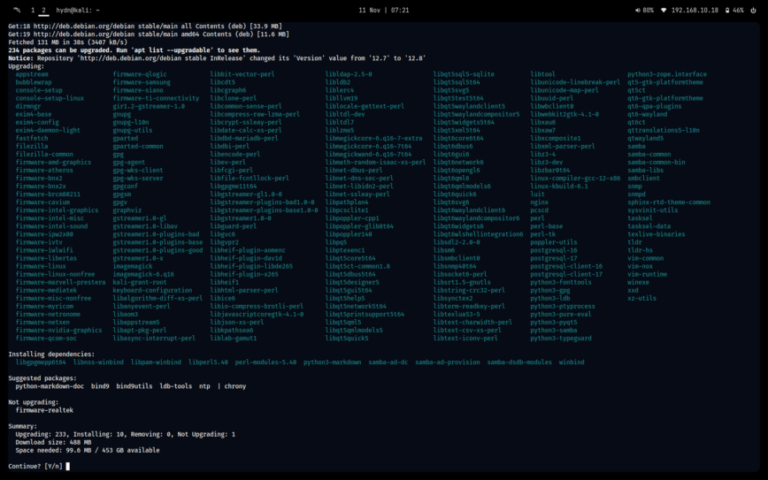ADVERTISEMENT
Let’s Encrypt is a widely known certificate authority that provides free SSL certificates for websites, launched in April 2016.
With the help of Certbot client, certificate creation, validation, signing, implementation, and renewal of certificates are fully automated.
Prerequisites
Contents
Follow the links to have either LAMP stack or only Apache web server installed on your system.
READ: How To Install LAMP Stack on CentOS 8 / RHEL 8
READ: How To Install LAMP Stack on CentOS 7 / RHEL 7
Install Certbot Client
To generate and install a certificate for any domain, you should have terminal access, and Certbot ACME client installed on the system. Certbot client automates certificate issuance and installation with no downtime.
Certbot client is available on EPEL repository for CentOS 7 / RHEL 7. But, we need to download Certbot client manually for CentOS 8 / RHEL 8 from its official site.
### CentOS 8 / RHEL 8 ### yum install -y httpd mod_ssl curl -O https://dl.eff.org/certbot-auto mv certbot-auto /usr/local/bin/certbot-auto chmod 0755 /usr/local/bin/certbot-auto ### CentOS 7 ### rpm -ivh https://dl.fedoraproject.org/pub/epel/epel-release-latest-7.noarch.rpm yum install -y certbot python2-certbot-apache ### RHEL 7 ### rpm -ivh https://dl.fedoraproject.org/pub/epel/epel-release-latest-7.noarch.rpm subscription-manager repos --enable rhel-7-server-optional-rpms yum install -y certbot python2-certbot-apache
Create Virtual Host
We will create a virtual host for the domain: www.itzgeek.net.
This virtual host handles the HTTP version of your domain.
vi /etc/httpd/conf.d/www.itzgeek.net.conf
Use the below information.
<VirtualHost *:80> ServerName itzgeek.net ServerAlias www.itzgeek.net DocumentRoot /var/www/www.itzgeek.net <Directory /var/www/www.itzgeek.net> Options -Indexes +FollowSymLinks AllowOverride All </Directory> ErrorLog /var/log/httpd/www.itzgeek.net-error.log CustomLog /var/log/httpd/www.itzgeek.net-access.log combined </VirtualHost>
Create a document root to place your HTML files.
mkdir -p /var/www/www.itzgeek.net
Place the HTML file inside the document root of your domain.
echo "This is a test site @ www.itzgeek.net" > /var/www/www.itzgeek.net/index.html
Change the permission of the directory.
chown -R apache:apache /var/www/www.itzgeek.net
Restart the Apache service.
systemctl restart httpd
Create / Update DNS Record
Go to your domain registrar and create an A/CNAME record for your domain. Ex: www.itzgeek.net.

Wait for some time to let the record propagate.
ADVERTISEMENT
Check the DNS propagation using Nslookup yum install -y bind-utils utility.

Install Let’s Encrypt SSL Certificate
Use the certbot command to generate and install Let’s Encrypt certificate.
### RHEL 8 ### /usr/local/bin/certbot-auto --apache ### CentOS 7 / RHEL 7 ### certbot --apache
Follow the interactive prompt and install the certificate.
Saving debug log to /var/log/letsencrypt/letsencrypt.log Plugins selected: Authenticator apache, Installer apache Enter email address (used for urgent renewal and security notices) (Enter 'c' to cancel): itzgeek.web@gmail.com << Enter Email address to receive notifications - - - - - - - - - - - - - - - - - - - - - - - - - - - - - - - - - - - - - - - - Please read the Terms of Service at https://letsencrypt.org/documents/LE-SA-v1.2-November-15-2017.pdf. You must agree in order to register with the ACME server at https://acme-v02.api.letsencrypt.org/directory - - - - - - - - - - - - - - - - - - - - - - - - - - - - - - - - - - - - - - - - (A)gree/(C)ancel: A << Agree to Terms of Sevice - - - - - - - - - - - - - - - - - - - - - - - - - - - - - - - - - - - - - - - - Would you be willing to share your email address with the Electronic Frontier Foundation, a founding partner of the Let's Encrypt project and the non-profit organization that develops Certbot? We'd like to send you email about our work encrypting the web, EFF news, campaigns, and ways to support digital freedom. - - - - - - - - - - - - - - - - - - - - - - - - - - - - - - - - - - - - - - - - (Y)es/(N)o: Y << Subscribe to Newsletter Which names would you like to activate HTTPS for? - - - - - - - - - - - - - - - - - - - - - - - - - - - - - - - - - - - - - - - - 1: itzgeek.net 2: www.itzgeek.net - - - - - - - - - - - - - - - - - - - - - - - - - - - - - - - - - - - - - - - - Select the appropriate numbers separated by commas and/or spaces, or leave input blank to select all options shown (Enter 'c' to cancel): 2 << Choose the domain to install Let's Encrypt SSL certificate Obtaining a new certificate Performing the following challenges: http-01 challenge for www.itzgeek.net Waiting for verification... Cleaning up challenges Created an SSL vhost at /etc/httpd/conf.d/www.itzgeek.net-le-ssl.conf Deploying Certificate to VirtualHost /etc/httpd/conf.d/www.itzgeek.net-le-ssl.conf Please choose whether or not to redirect HTTP traffic to HTTPS, removing HTTP access. - - - - - - - - - - - - - - - - - - - - - - - - - - - - - - - - - - - - - - - - 1: No redirect - Make no further changes to the webserver configuration. 2: Redirect - Make all requests redirect to secure HTTPS access. Choose this for new sites, or if you're confident your site works on HTTPS. You can undo this change by editing your web server's configuration. - - - - - - - - - - - - - - - - - - - - - - - - - - - - - - - - - - - - - - - - Select the appropriate number [1-2] then [enter] (press 'c' to cancel): 2 << Redirect from HTTP to HTTPS Redirecting vhost in /etc/httpd/conf.d/www.itzgeek.net.conf to ssl vhost in /etc/httpd/conf.d/www.itzgeek.net-le-ssl.conf - - - - - - - - - - - - - - - - - - - - - - - - - - - - - - - - - - - - - - - - Congratulations! You have successfully enabled https://www.itzgeek.net You should test your configuration at: https://www.ssllabs.com/ssltest/analyze.html?d=www.itzgeek.net - - - - - - - - - - - - - - - - - - - - - - - - - - - - - - - - - - - - - - - - IMPORTANT NOTES: - Congratulations! Your certificate and chain have been saved at: /etc/letsencrypt/live/www.itzgeek.net/fullchain.pem Your key file has been saved at: /etc/letsencrypt/live/www.itzgeek.net/privkey.pem Your cert will expire on 2019-11-10. To obtain a new or tweaked version of this certificate in the future, simply run certbot-auto again with the "certonly" option. To non-interactively renew *all* of your certificates, run "certbot-auto renew" - Your account credentials have been saved in your Certbot configuration directory at /etc/letsencrypt. You should make a secure backup of this folder now. This configuration directory will also contain certificates and private keys obtained by Certbot so making regular backups of this folder is ideal. - If you like Certbot, please consider supporting our work by: Donating to ISRG / Let's Encrypt: https://letsencrypt.org/donate Donating to EFF: https://eff.org/donate-le
Firewall
Configure the firewall to allow HTTPS requests.
firewall-cmd --permanent --add-port=443/tcp firewall-cmd --reload
Verify Let’s Encrypt Certificate
Verify the Let’s Encrypt certificate by visiting the HTTPS version of your website.
http://your-http-web-site
OR
https://your-https-web-site
You should now get an HTTPS version of your site.

Test Let’s Encrypt SSL Certificate
Test your SSL certificate for problems and its security ratings by going to the below URL.
https://www.ssllabs.com/ssltest/analyze.html?d=www.itzgeek.net

Renew Let’s Encrypt Certificate
Let’s Encrypt certificate is valid for 90 days from the date of issuance, and it needs to be renewed before it expires.
In CentOS 7 / RHEL 7, by default, the certbot client creates a cron scheduler entry to renew Let’s Encrypt certificates automatically.
Unfortunately, for CentOS 8 / RHEL 8, we need to configure the cron scheduler manually.
echo "0 0,12 * * * root python -c 'import random; import time; time.sleep(random.random() * 3600)' && /usr/local/bin/certbot-auto renew" | sudo tee -a /etc/crontab > /dev/null
You can also simulate the certificate renewal process with the below command to ensure the renewal goes smooth.
### CentOS 8 / RHEL 8 ### /usr/local/bin/certbot-auto renew --dry-run ### CentOS 7 / RHEL 7 ### certbot renew --dry-run
To renew the Let’s Encrypt certificate, execute the above command without --dry-run option.
Output:
Saving debug log to /var/log/letsencrypt/letsencrypt.log - - - - - - - - - - - - - - - - - - - - - - - - - - - - - - - - - - - - - - - - Processing /etc/letsencrypt/renewal/www.itzgeek.net.conf - - - - - - - - - - - - - - - - - - - - - - - - - - - - - - - - - - - - - - - - Cert not due for renewal, but simulating renewal for dry run Plugins selected: Authenticator apache, Installer apache Renewing an existing certificate Performing the following challenges: http-01 challenge for www.itzgeek.net Waiting for verification... Cleaning up challenges - - - - - - - - - - - - - - - - - - - - - - - - - - - - - - - - - - - - - - - - new certificate deployed with reload of apache server; fullchain is /etc/letsencrypt/live/www.itzgeek.net/fullchain.pem - - - - - - - - - - - - - - - - - - - - - - - - - - - - - - - - - - - - - - - - - - - - - - - - - - - - - - - - - - - - - - - - - - - - - - - - - - - - - - - - ** DRY RUN: simulating 'certbot renew' close to cert expiry ** (The test certificates below have not been saved.) Congratulations, all renewals succeeded. The following certs have been renewed: /etc/letsencrypt/live/www.itzgeek.net/fullchain.pem (success) ** DRY RUN: simulating 'certbot renew' close to cert expiry ** (The test certificates above have not been saved.) - - - - - - - - - - - - - - - - - - - - - - - - - - - - - - - - - - - - - - - - IMPORTANT NOTES: - Your account credentials have been saved in your Certbot configuration directory at /etc/letsencrypt. You should make a secure backup of this folder now. This configuration directory will also contain certificates and private keys obtained by Certbot so making regular backups of this folder is ideal.
If the output does not report any problem, then the certificate renewal will work as expected.
Conclusion
That’s All. I hope you learned how to setup Let’s Encrypt SSL Certificate with Apache on CentOS 8 / RHEL 8 & CentOS 7 / RHEL 7. Share your feedback in the comments section.






